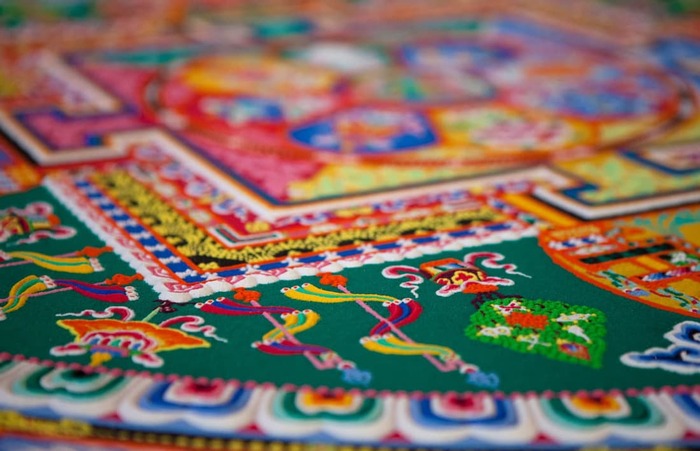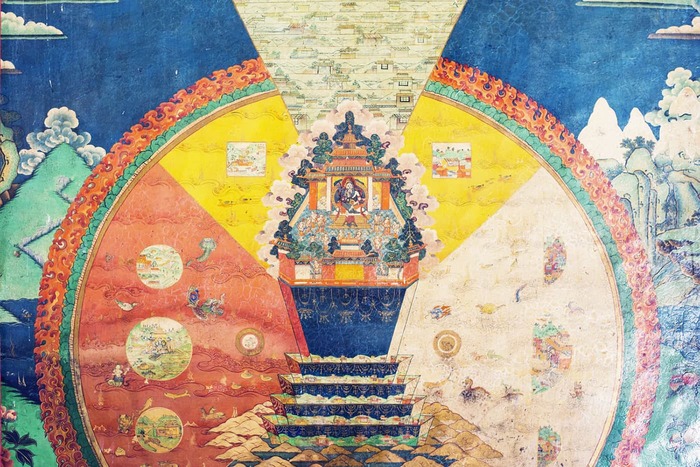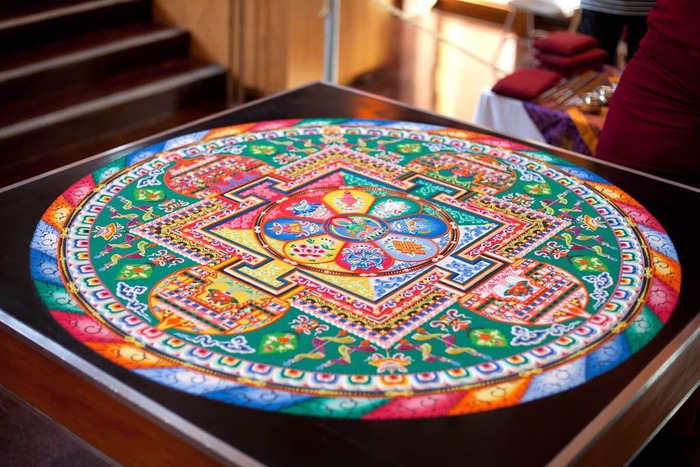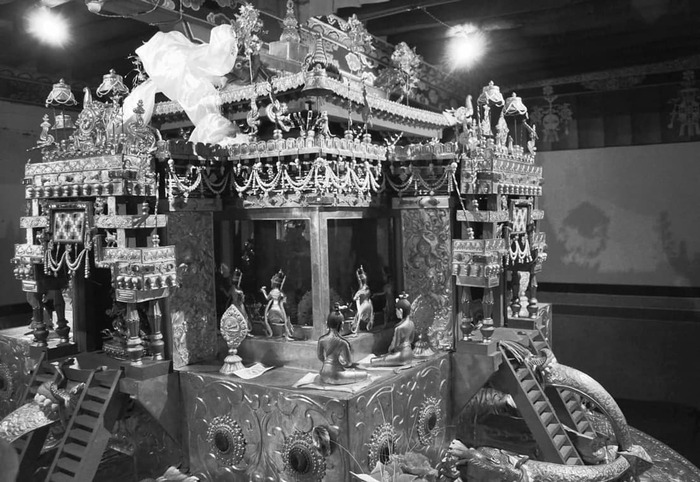Introduction
Mandalas originated in India thousands of years ago as an aid for certain advanced Hindu and Buddhist meditation practices, and have today entered the public consciousness. In the early 20th century, the Swiss psychoanalyst Carl Jung introduced mandalas into Western thought as a therapeutic tool for exploring the unconscious. Over the years, pop culture has taken the term “mandala” not only for New Age concepts, but adopted it as a brand name for hotels, spas, nightclubs, magazines and more. More recently, Tibetan monks have constructed brightly-colored sand mandalas in museums around the world, to display the sophisticated culture of Tibet. So, what exactly is a mandala?
A mandala is a round symbol of a universe, used to represent a deeper meaning.
Mandalas are used in many types of Buddhist meditation [read more about Buddhist meditation here] and practice. This article will look at the major ones.

Mandalas in Tantra
In the advanced practices known as "tantra," [read more about tantra here], meditators dissolve their ordinary self-image of a solid, permanent “me,” and instead imagine themselves in the form of a yidam, or Buddha-figure. These represent one or more aspects of a fully enlightened Buddha, such as the relatively well-known example of Avalokiteshvara as the embodiment of compassion. Tantric practitioners imagine themselves in the form of Avalokiteshvara, and feel that they embody compassion just as he does. By imagining that we’re already able to help others just like the Buddha-figure can – while being fully aware that we are not quite there yet – we can build up the causes for our own enlightenment efficiently and effectively.

Buddha-figures live in totally pure worlds known as mandalas, with the term “mandala” referring not just to the environment of that world, but also the beings who inhabit it. Each of the worlds is slightly different, but in general they comprise of an ornate square palace situated in the middle of a beautiful landscape, surrounded by a round protective barrier that wards off interferences to the meditation practice. The main figure could be male or female, on their own or as a couple, sitting or standing in the center of the palace. They’re often surrounded by an array of other figures, and sometimes there are additional figures outside the palace as well. Many of them have multiple faces, arms and legs, and hold a variety of hand implements.
Engaging in tantric practice requires an empowerment or initiation, [read more about initiations here], a beautiful and elaborate ceremony led by a fully qualified tantric master. During the empowerment, a two-dimensional drawing of the Buddha-figure’s mandala is arranged near the master, normally painted on a cloth or made of sand, and then enclosed inside the wooden frame of a simplified version of the palace. If we visualize mandalas, however, we always see them as three-dimensional.
During the ritual ceremony, the master confers vows on the initiates and grants permission to enter the palace, whereby they imagine themselves walking inside. Through various visualizations, their so-called “Buddha-nature” potentials to achieve enlightenment through the practice are activated. If the mandala was constructed out of sand, the grains are swept into a pile in a closing ceremony, representing impermanence, and offered into a body of water.

After this, the initiates are empowered to visualize themselves as the figures and the mandala as part of their daily practice. Each figure and the implement they hold represents something associated with the meditation practice. For instance, the six arms of a figure might represent the six perfections or far-reaching attitudes.
Practitioners not only imagine that they are all the figures inside and outside the palace, but they imagine that they are the palace as well, with the various architectural features of the mandala palace also representing various aspects of meditation practice. In some mandalas, the four walls might represent the four noble truths, while the palace being square with equal-length sides indicates that in terms of emptiness or voidness, the Buddhas and the not-yet-enlightened are equal.

Some very advanced tantric meditations even have visualizations of parts of their body as parts of the palace, or various figures of the palace situated inside their own body. This is called a “body mandala,” and is difficult because it requires excellent concentration and a thorough understanding of Buddhist philosophy.
Mandalas in General Practice
Before receiving any teaching – tantric or general – from a Buddhist teacher, the students offer a mandala of request, while a mandala of thanksgiving is offered at the end. Here, the mandala represents a perfect universe full of precious objects. Because the students value the teaching more than anything else in the world, offering the mandala signifies their willingness to give anything and everything to receive it.

The mandala offering can be in the form of a flat-bottomed bowl, held bottom-side up, with mounds of raw grain or gems placed one atop the other on the surface, contained within progressively smaller concentric rings. It is then crowned with an ornamental diadem. Alternatively, it can be made with a hand “mudra,” with the fingers intertwined in a specific pattern. In both cases, the mandala represents the idealized vision of the universe that appears in traditional Buddhist literature. When offering mandalas, students recite verses, wishing that all conditions throughout the world might be conducive to receiving teachings, and that all beings might be able to live in such a perfect world and partake of these wonderful teachings.

Many Buddhists perform “preliminary practices” (ngondro in Tibetan) – usually entailing 100,000 repetitions of certain practices – as a preparation for engaging in more advanced meditations. These preliminaries help to eliminate emotional blocks and build up the positive force needed to succeed in their meditation practice. Offering a mandala 100,000 times is one of the preliminary practices, and it aids in ridding practitioners of their reticence in devoting their full time and effort to the meditations, and it builds up a strong willingness to give everything in order to succeed.

Summary
As we’ve seen, mandalas are used in various Buddhist practices to represent not just the universe, but also the numerous facets of the Buddhist path. While Tibetan monks continue to construct beautiful sand mandalas at venues across the world to raise awareness of the Tibetan situation, it’s important not to view them as merely an exotic form of art. Mandalas are a sophisticated meditation tool that constitutes a central role in both general and advanced tantra practice, and that helps to further us on our path to enlightenment.
See also: